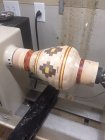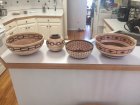I am a segmenter. Any vessel with depth, like a vase, is glued up in sections (1-3 sections).
If I use two sections (halves), the segments are glued directly to waste blocks on separate faceplates. One half has the bottom ring is glued to the bottom waste block, stacking rings towards the center of the vessel. The other half starts with the top ring glued to the waste block working toward the center.
As I stack rings, I true and flatten them only keeping maximum thickness. Once halves are stacked, glued and trued, I put them together “dryfit” between centers including waste blocks and faceplates.
I turn the outside form to where I want it. I then separate the halves again and turn the inside of each to matching wall thickness using calipers to maintain uniform thickness. The halves are sanded and finished on the inside. The two halves are then glued together using masking tape to keep Glue squeeze out contained on the interior.
Once dry, I remove the top waste block giving me access to the inside of the vessel. Typically, a little touch up is required along the glue joint only on the inside. I then finish the outside, part it off the bottom waste block, finish the bottom to complete.
Doing three or more sections complicates matters but is basically the same drill. This is the easiest way to turn, and finish deeper segmented vessels IMO.
I highly recommend getting Malcolm Tibbett’s first book on Segmenting (one of several). His basic techniques are tried and true; what I do is gleamed from his developed techniques. He deserves mentioning as he is one of my Gurus and a huge innovator in the world of Segmenting!
There is also an AAW group dedicated to Segmenting - Segmentedwoodturners.org that will help you hone your segmenting skills. It has a huge library of pieces, tutorials and a membership always willing to answer your questions! Check it out for a free trial!



